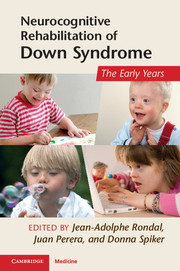Book contents
- Frontmatter
- Contents
- List of contributors
- Preface
- Acknowledgments
- Section 1 Definition, history, methodology, and assessment
- Section 2 Genetics, brain, and animal models
- 4 New perspectives on molecular and genic therapies in Down syndrome
- 5 Brain plasticity and environmental enrichment in Ts65Dn mice, an animal model for Down syndrome
- 6 Development of the brain and metabolism
- Section 3 Pharmacological and medical management and treatment
- Section 4 Early development and intervention
- Section 5 Therapeutic perspectives
- Conclusions
- Index
- References
5 - Brain plasticity and environmental enrichment in Ts65Dn mice, an animal model for Down syndrome
Published online by Cambridge University Press: 05 July 2011
- Frontmatter
- Contents
- List of contributors
- Preface
- Acknowledgments
- Section 1 Definition, history, methodology, and assessment
- Section 2 Genetics, brain, and animal models
- 4 New perspectives on molecular and genic therapies in Down syndrome
- 5 Brain plasticity and environmental enrichment in Ts65Dn mice, an animal model for Down syndrome
- 6 Development of the brain and metabolism
- Section 3 Pharmacological and medical management and treatment
- Section 4 Early development and intervention
- Section 5 Therapeutic perspectives
- Conclusions
- Index
- References
Summary
The concept of neuronal plasticity and enriched environment
With an occurrence of ~1 in 800 live births, Down syndrome (DS), a chromosome 21 (HSA21) trisomy, is the most common genetic cause of mental retardation (Epstein, 1986). Although the somatic phenotype of DS affects nearly every organ in the body, the predominant and most consistent feature of DS is subnormal intellectual functioning, ranging from mild to severe (Chapman & Hesketh, 2000), resulting from abnormal cognitive and language development, learning and memory impairments, and significant behavioral alterations (Pennington et al., 2003). Underlying the complex neurological phenotype of DS are a number of different central nervous system abnormalities such as hypocellularity (already observed in the fetus), delayed myelination, altered cortical lamination, dendritic and synaptic alterations, and abnormal neurogenesis (Wisniewski et al., 2006). Despite enormous scientific efforts, the cause of the subnormal intellectual functioning of DS patients on the molecular level remains unanswered. It is also unknown whether, which, and to what extent the developmental abnormalities caused by the triplicated chromosome 21 can be mitigated by environmental factors and behavioral therapies (Guralnick, 2005).
Although sophisticated genetic and epigenetic programs predetermine the structural integrity and basal functionality of the mammalian brain at the time of birth, further brain development and refinement of neuronal circuitry are determined through interaction with the surrounding environment. Only with the development of the concepts of neuronal (brain) plasticity and enriched environment has it been possible to more rigorously study the effect of environment on the development and functioning of the mammalian brain in adulthood, under normal and various pathological conditions, both genetic and acquired.
- Type
- Chapter
- Information
- Neurocognitive Rehabilitation of Down SyndromeEarly Years, pp. 71 - 84Publisher: Cambridge University PressPrint publication year: 2011
References
- 3
- Cited by



